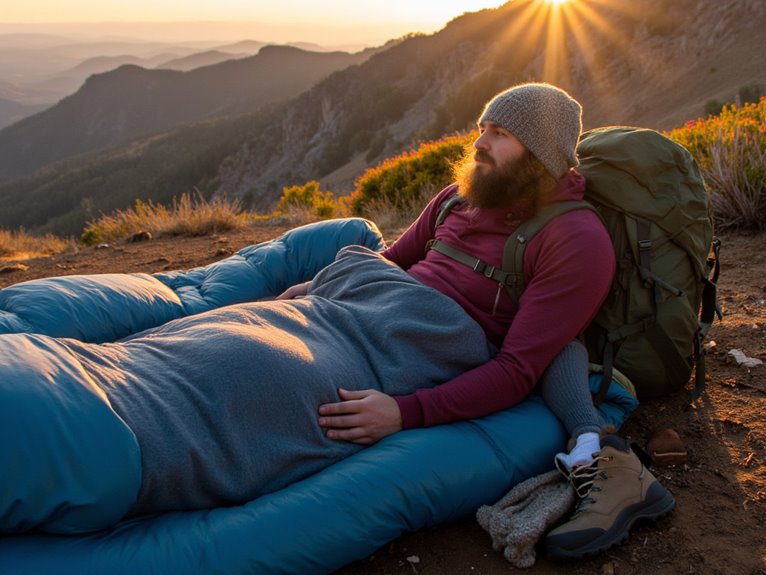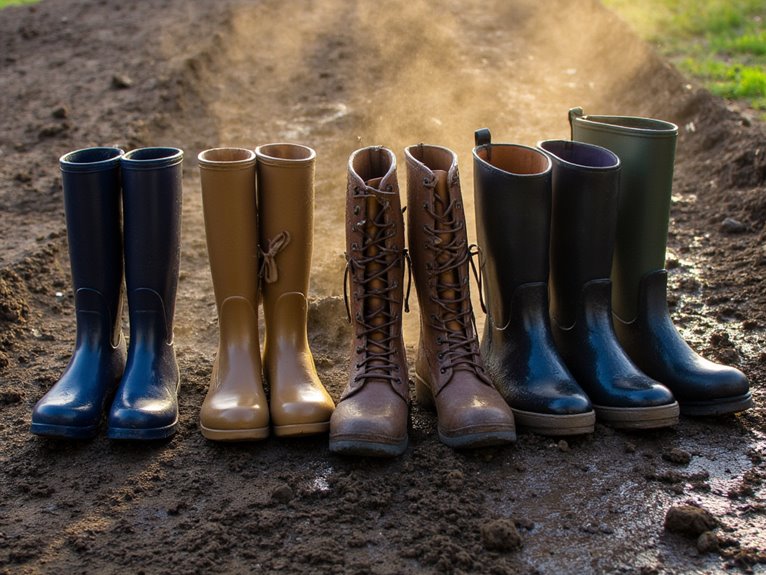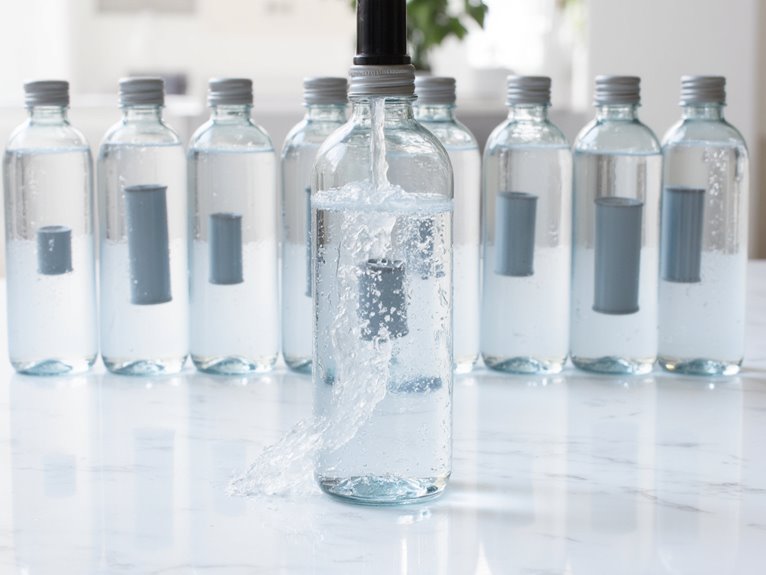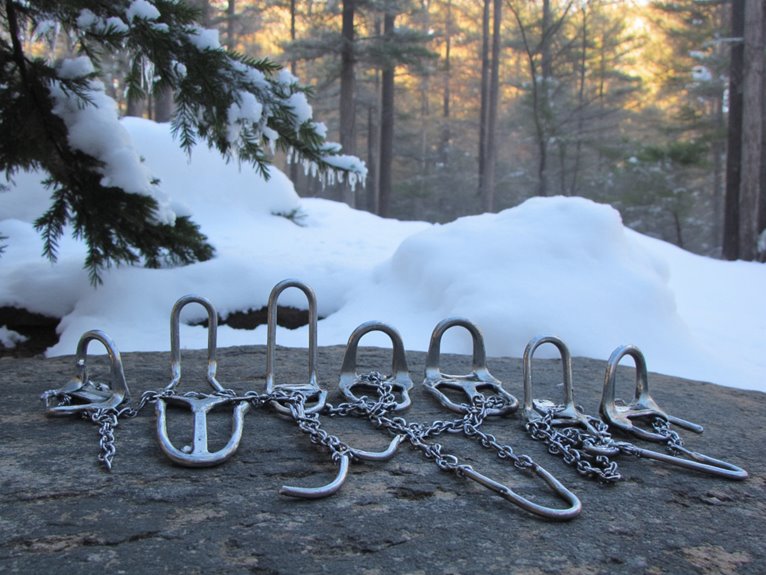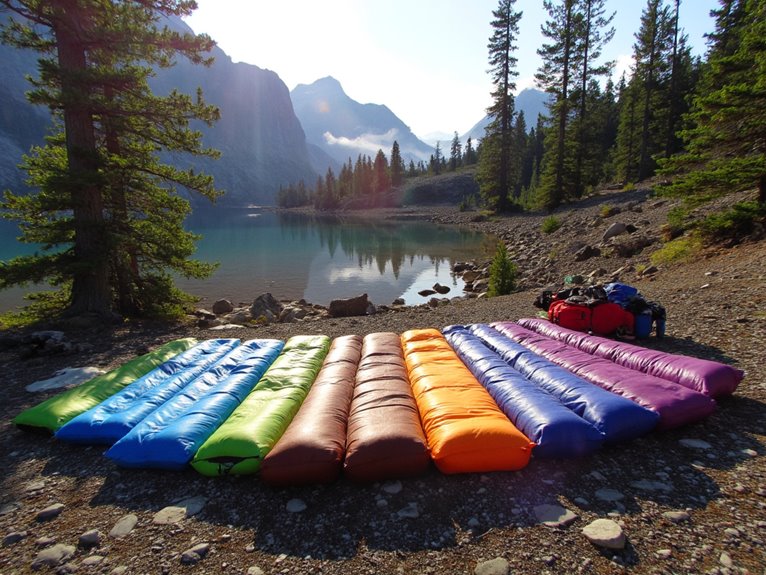What to Wear to Sleep While Backpacking (Base Layers & Warmth Hacks)
You’ll want moisture-wicking merino wool or synthetic base layers for ideal sleep comfort while backpacking. Never sleep in hiking clothes—always change into clean, dry base layers to prevent moisture accumulation and hypothermia risk. For temperatures above 35°F, lightweight merino wool works perfectly. Below 20°F, add heavy base layers with fleece midlayers, and consider wearing your insulated jacket inside your sleeping bag. Pair these with wool socks, a fleece beanie, and verify your sleeping pad has an R-value of 4+ for proper ground insulation—these fundamentals open up advanced warmth retention techniques.
We are supported by our audience. When you purchase through links on our site, we may earn an affiliate commission, at no extra cost for you. Learn more. Last update on 10th December 2025 / Images from Amazon Product Advertising API.
Notable Insights
- Choose moisture-wicking base layers made from merino wool or synthetic materials, avoiding cotton which loses insulation when wet.
- Layer strategically for temperature: lightweight fabrics for warm weather, heavy base layers with fleece for cold conditions below 35°F.
- Always sleep in clean, dry clothes separate from hiking gear to prevent moisture accumulation and maintain optimal warmth.
- Use a sleeping pad with R-value 4+ for proper ground insulation, especially crucial in cold weather for heat retention.
- Add warmth accessories like wool beanies, down booties, and hot water bottles to enhance heat retention during cold nights.
Essential Base Layers for Backpacking Sleep Systems
When you’re selecting base layers for backpacking sleep systems, moisture management becomes the primary factor determining your comfort and safety throughout the night. Your base layer acts as the foundation of your sleep system, wicking perspiration away from your skin to prevent dangerous chilling in cold conditions.
Base layers address your insulation needs by trapping warm air close to your body while allowing moisture transfer. This dual function maintains thermal regulation throughout temperature fluctuations. Quality base layers provide versatility for both warm and cold camping conditions.
The layering principle allows you to add or remove clothing as temperatures change. Soft fabrics promote comfort during extended sleep periods, preventing chafing and irritation that disrupts rest.
Choose moisture-wicking materials that complement your sleeping bag’s insulation properties for ideal thermal performance.
Choosing the Right Fabrics for Overnight Comfort
Your choice of fabric directly determines how well you’ll sleep during multi-day backpacking trips. Understanding fabric properties helps you avoid moisture retention issues that compromise warmth and comfort.
| Fabric | Moisture Management | Temperature Regulation | Durability |
|---|---|---|---|
| Ultra-fine Merino Wool | Excellent wicking, fast drying | Superior regulation, prevents overheating | High, requires careful washing |
| Synthetic (Polyester/Nylon) | Rapid drying, reduces clamminess | Maintains warmth when damp | Very high, machine washable |
| Silk | Slow moisture wicking | Comfortable but limited in cold | Low, vulnerable to abrasion |
| Cotton | Poor – absorbs and retains moisture | Loses insulation when wet | Low under heavy use |
Merino wool offers natural antimicrobial properties, staying odor-free for days. Synthetics excel in packability and maintenance but develop odors quickly. Cotton should be avoided entirely. These fabric considerations become especially important when paired with your sleeping bag choice, as synthetic insulation maintains thermal protection when wet while down can lose up to 90% of its insulating power in damp conditions.
Undergarments and Intimate Apparel for the Trail
While most backpackers obsess over their sleeping bags and base layers, underwear selection can make or break your overnight comfort on multi-day trips.
Quality hiking underwear delivers moisture wicking performance through synthetic blends or merino wool construction. Polyester and nylon fabrics excel at quick-drying capabilities, while merino wool naturally provides superior odor control for extended wear.
Seamless designs eliminate chafing prevention concerns under fitted base layers. Spandex blends create fit options that conform without constriction during sleep movement. Breathability features like mesh panels enhance air circulation in critical areas.
Fabric durability varies considerably between materials. Synthetics resist abrasion better than wool but lack natural antimicrobial properties.
Choose underwear that balances fast-drying performance with multi-day odor resistance for ideal trail comfort.
Sleepwear Options for Warm Weather Conditions
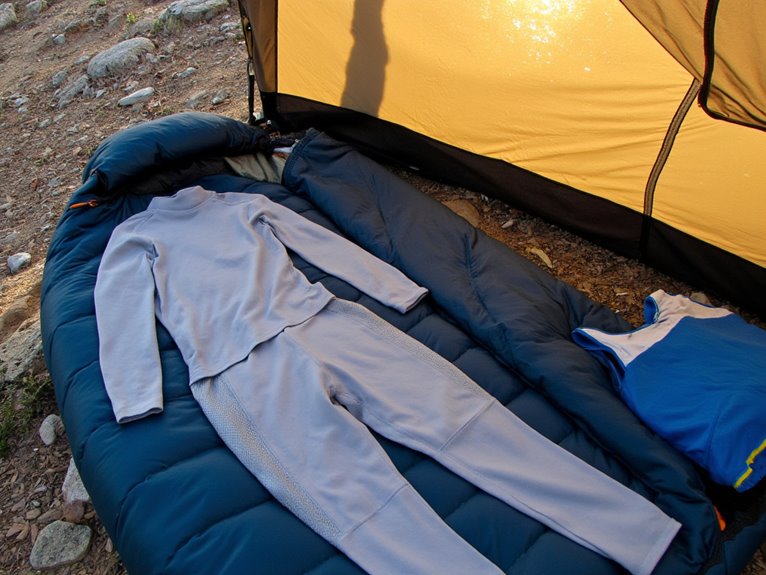
When temperatures rise on the trail, your sleepwear selection becomes critical for maintaining comfort and preventing overheating during rest periods.
You’ll need lightweight, moisture-wicking fabrics like merino wool, polyester, or nylon that can handle sweat management while providing adequate breathability through the night.
Short-sleeve shirts, tank tops, or camisoles offer the best combination of minimal coverage and maximum ventilation for warm weather conditions.
Lightweight Fabric Choices
Since fabric selection directly impacts your comfort and pack weight during warm weather backpacking, understanding the performance characteristics of different materials becomes essential for making informed sleepwear choices.
Polyester excels in fabric performance analysis through its quick-drying properties and durability. You’ll find it ideal for lightweight sleepwear when temperatures rise.
Nylon offers superior abrasion resistance while maintaining low pack weight.
Merino wool’s ultra-fine fibers eliminate itchiness while delivering exceptional moisture management techniques that keep your skin dry throughout the night.
Synthetic fabrics like polyester and nylon prioritize rapid moisture transfer over tactile comfort.
Merino wool balances breathability with natural odor resistance.
Laminate composites combine multiple materials to optimize weight-to-performance ratios.
Your fabric choice should prioritize moisture-wicking capabilities, breathability, and fast-drying properties for warm weather conditions.
Breathable Layer Options
Your fabric selection establishes the foundation, but specific breathable layer configurations determine your actual comfort level during warm weather backpacking. Cotton and merino wool offer superior breathable fabrics with moisture wicking properties that regulate body temperature effectively.
| Layer Type | Material | Weight (oz) | Moisture Wicking | Packability |
|---|---|---|---|---|
| Base Layer | Merino Wool | 3-4 | Excellent | High |
| Sleep Shirt | Cotton Blend | 2-3 | Good | Medium |
| Lightweight Tee | Synthetic | 2-3 | Very Good | High |
| Tank Top | Bamboo Fiber | 1-2 | Excellent | High |
| Sleep Shorts | Modal Blend | 2-3 | Good | Medium |
These materials manage sweat accumulation while maintaining airflow. Merino wool provides versatility across temperature ranges, functioning effectively in both warm and shifting conditions. Lightweight construction guarantees minimal pack weight while maximizing comfort during variable nighttime temperatures.
Ventilation and Cooling
Effective heat dissipation becomes critical when nighttime temperatures hover above 70°F, requiring strategic sleepwear choices that maximize airflow while preventing overheating.
Select garments with mesh panels or zippered ventilation features that allow precise temperature control throughout the night. Loose-fitting sleepwear creates air pockets around your body, facilitating convective cooling through natural circulation patterns.
Strategic exposure techniques enhance thermal regulation considerably. Sleep with arms and legs partially uncovered to increase surface area for heat release. Remove socks and footwear completely—your extremities serve as primary cooling zones during rest periods.
Position your sleeping area near natural airflow sources when possible.
These ventilation techniques work synergistically with proper fabric selection. Quick-drying synthetic blends prevent moisture accumulation that can disrupt your body’s cooling strategies, while lightweight natural fibers maintain breathability without restricting essential airflow patterns around pressure points.
Cold Weather Sleep Clothing and Layering Strategies
Three fundamental principles govern cold weather sleep clothing for backpackers: material selection, moisture management, and strategic layering.
Never sleep in clothes you’ve worn while hiking. Merino wool base layers offer superior warmth-to-weight ratios and natural odor resistance. Synthetic fabrics like polyester provide excellent moisture-wicking properties and faster drying times.
Your layering strategies should adapt to overnight temperature forecasts:
- Heavyweight base layers for temperatures above 35°F
- Medium-weight wool or synthetic base layers for 20-35°F conditions
- Heavy base layers plus thin fleece midlayer for sub-20°F nights
- Full insulated jacket inside sleeping bag for extreme cold below 0°F
Keep sleep clothes completely dry using waterproof storage bags.
Avoid cotton entirely—it retains moisture and increases hypothermia risk in cold weather conditions.
Your sleeping pad’s R-value significantly impacts how much clothing you’ll need, as inadequate ground insulation can force you to wear additional layers to compensate for heat loss.
Accessories for Maximum Warmth Retention
Beyond base layers and sleeping bags, strategic accessories form the final defense against heat loss during cold-weather backpacking nights.
Headwear insulation proves critical since you’ll lose significant body heat through your head. Choose fleece or wool beanies that wick moisture while trapping warmth. Balaclavas provide additional face and neck protection.
Your head acts as a thermal chimney, making insulated headwear essential for preventing critical heat loss during frigid backpacking nights.
Extremity warmth requires dedicated attention. Down booties designed for sleeping offer superior foot insulation with minimal weight. Lightweight insulated gloves prevent hand heat loss while maintaining dexterity. Chemical hand warmers boost warmth inside gloves during extreme conditions.
System enhancements multiply your sleep warmth. Ultralight top quilts add thermal layers above sleeping bags. Closed-cell foam beneath sleeping pads blocks ground heat transfer. Hot water bottles create radiant heat sources inside your bag, delivering hours of additional warmth. Quality sleeping pads with higher R-values provide superior thermal efficiency, especially crucial when temperatures drop below 40°F.
Pro Tips and Hacks for Staying Warm Overnight
Beyond proper clothing layers, you’ll need specific heat retention techniques and emergency warmth solutions to maintain core temperature during frigid nights.
These methods range from generating internal heat through calorie-dense foods to creating external heat sources using gear you already carry.
When temperatures drop unexpectedly or your primary warmth systems fail, these backup strategies can prevent dangerous heat loss and guarantee a safe night’s sleep.
Heat Retention Techniques
When temperatures drop below freezing, your body’s natural heat production alone won’t keep you comfortable through the night without strategic heat retention techniques.
Effective thermal layering and insulation techniques require understanding heat transfer principles and implementing proven methods.
Four essential heat retention strategies include:
- Hot water bottle preparation – Fill an ultralight HDPE Nalgene bottle with hot water and insulate it with wool socks for 4-6 hours of warmth.
- Ground insulation optimization – Use closed-cell pads with R-value 4+ to prevent conductive heat loss to cold surfaces.
- Microclimate creation – Seal sleeping bag zippers completely and wear a hat to minimize heat loss from your head.
- Pre-sleep heating – Consume hot food and drinks immediately before sleeping to elevate core temperature through metabolic heat generation.
Emergency Warmth Solutions
Although standard heat retention methods work well in most conditions, extreme cold or equipment failure scenarios demand proven emergency warmth solutions that can mean the difference between a challenging night and a dangerous situation.
Emergency blankets provide critical backup warmth. Use the reflective side inward to retain body heat, or layer between your sleeping bag and pad for increased insulation. Mylar blankets weigh under three ounces and compress to pocket size.
Non fire heating options include small candles for ambient tent warmth and hot water bottles. Fill a Nalgene bottle rated for high temperatures before bed, then wrap it in a sock.
Chemical hand warmers serve as reliable backup heat sources.
Layer extra insulation at night—puffy jackets and insulated pants boost sleep system warmth considerably.
Consume high-calorie snacks before bed to fuel internal heat generation.

